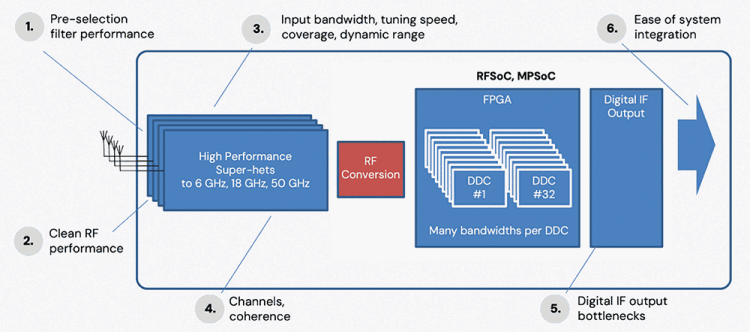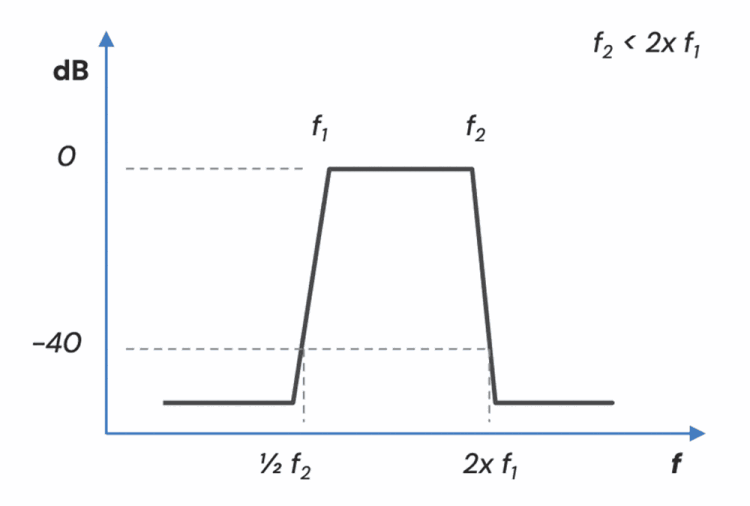
A common use-case for the highest performance software defined radios (SDRs) is airborne situational awareness. As the spectrum gets increasingly crowded, and adversaries more capable, the task of examining wide bands and making sense of it all, while not missing anything, gets harder. As with any engineering challenge, making the right trade-offs is crucial, and this application note looks at some of the relevant ones.

Figure 1 shows a highly simplified block diagram. The centre of many SDRs is some kind of System-on-Chip (SoC) such as components from Xilinx or Analog Devices.
Some aspects to consider include:
1. In crowded spectral environments, filtering out strong interfering signals adjacent to the one of interest is important, particularly as the latter is usually weak. The inevitable loss penalty of inserting a filter early in the block diagram is usually worth paying when strong unwanted signals left unattenuated will stimulate spur generation in active non-linear devices that follow. Filters are usually sub-octave, such that the upper frequency corner is less than twice the lower frequency corner so that harmonics of the lowest frequency passed receive some attenuation. Requirements for the highest performance systems can be quite exacting, as shown in figure 2.
2. Further efforts to keep the RF chain as clean as possible can be achieved architecting the first IF (intermediate frequency) to be above the maximum input frequency of the receiver. This results in improved image rejection, but adds the complication of higher frequency design and components.
3. The instantaneous bandwidth (IBW) that a radio is designed for has a direct bearing upon the dynamic range it is capable of achieving, with the narrower the better. However, a narrow IBW window means it needs to be tuned many more times to cover the whole frequency range compared to a larger window. It also makes tuning speed, including settling time of the components and control system, especially important.
4. Channel count can be used as a factor to compensate for narrower IBWs – the more chunks of spectrum being examined, the easier it is to cover the required range. Having multiple channels able to tune independently is helpful for search operations. However, being able to lock them together phase-coherently opens the possibility of direction finding (DF) and its cousin geo-location where several aircraft or other vehicles accurately triangulate on a target of interest. Accurate timecoding compared to GPS is another important feature to allow the different vehicles to synchronise readings.
5. A major advantage of conversion to the digital domain is the opportunity to process captured segments of spectrum many ways and focus on many signals of interest. Digital down converters (DDCs) allow this to happen, and an SDR might have 72 DDCs, or even as many as 512 in units with the biggest FPGAs. The downside of all of this is the sheer amount of data that must be transferred, particularly when systems use multiple channels as mentioned above. Modern high performance SDRs use very high-speed serial buses such as 10, 40 or even 100 Gigabit Ethernet (GbE) to pass data, but inevitable bottlenecks in the overall pipeline mean that careful management of DDC settings may be needed.

While it is obvious that exceptional RF design and digital design is needed for such systems, successful integration and deployment relies on many less obvious factors. These include:
• Absolute stability of firmware, software, and DSP code.
• Compliance with standards such as VITA 49 for data formatting.
• Accuracy and completeness of documentation.
These all contribute to overall system readiness on time and on-budget.
| Tel: | +27 12 667 5212 |
| Email: | [email protected] |
| www: | www.rfibersolutions.com |
| Articles: | More information and articles about RFiber Solutions |

© Technews Publishing (Pty) Ltd | All Rights Reserved